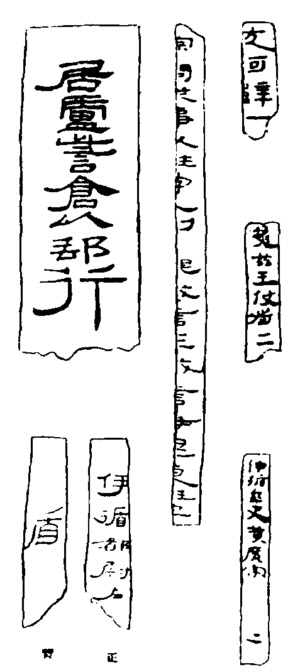Chapter 14 Section 5 Maps of the Han Dynasty and Place Names on the Han Bamboo Slips
After Qin merged the six countries and established a unified regime, it focused on "writing with the same text" as an important item. On the one hand, it eliminated some characters that were inconsistent with Qin Wen, and on the other hand, it changed the big seal script to small seal script to promote it.However, seal script is troublesome to write after all, so the official script, which is easy to write and recognize, is adopted, which is widely popular in society.The official script of the Qin and Han Dynasties is close to the regular script before simplification, so it is not difficult to identify the place names of the Qin and Han Dynasties.
The place names written by the Qin and Han people can be seen in some rare steles, and a large number of Han bamboo slips have been discovered in modern times, which provide rich materials for exploring the place names of the Han Dynasty.Although there was already paper at that time, it was just silk.The paper mentioned today was successfully trial-produced and gradually popularized by Cai Lun in the late Eastern Han Dynasty in the early 2nd century AD.
The compilation of maps in ancient China not only originated early, but also continued to develop continuously through the generations. In the winter of 1973, three maps drawn on silk were found in a Han tomb in Mawangdui, a suburb of Changsha.This is a military map made by the Western Han Dynasty to crusade against the independent South Vietnam.The topographic map is about 96 centimeters in length and width, including the border area of the three provinces of Hunan, Guangxi and Guangdong.There are 90 place names in the picture, and the fonts are between seal script and official script, most of which can be recognized.However, the orientation is up south, down north, left east and right west, which is opposite to this picture.The notes in the eight small boxes in the picture are the names of counties.Inside some small circles are general settlements.Jiuyi Mountain uses nine columns to highlight its status.These maps were drawn more than 2,000 years ago and are one of the oldest maps preserved in my country and the world.

Place names on Chinese bamboo slips
These pictures survived today because they were painted on what the ancients called "silk paper". If they were painted on grass paper, they could not be preserved.The characters written on bamboo boards and wood chips have been preserved for a longer time, such as the Tianshui Qin bamboo slips and wooden board pictures that have been preserved to this day.At the beginning of this century, a large number of bamboo slips of the Han Dynasty were unearthed in some areas in the Northwest. This is another great discovery after the oracle bone inscriptions. After 1949, in addition to new discoveries in Northwest China, some Han bamboo slips and Qin bamboo slips were also discovered in Linyi Yinqueshan and Yunmengsuihudi in the inland.Many of the unearthed bamboo slips contain place names, which not only provide rich information for exploring historical place names, but also obtain some ancient social, political, economic, and military information.Yixun (now Qiemodong, Xinjiang), Qiuci [qiuci Qiuci, today's Baicheng area of Luntai, Xinjiang], Jiaohebi (incomplete, in the west of today's Turpan), and Julu Zicang on the Han bamboo slips are all place names .Huang Wenbi (1893-1966, a famous archaeologist) believed that Julu Zi was a translated name from the Xiongnu language, and the word "Zi" was often omitted in Chinese books.Ding Qian (1843-1919, a geographer) believed that the land was in the west of Yumenguan, Wang Guowei (1877-1927, a famous scholar) believed that it was in Loulan, west of Lop Nur, and Huang Wenbi believed that Julucang was not in Loulan but in the southeast of Loulan .

Place names on Chinese bamboo slips
